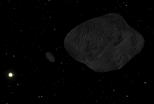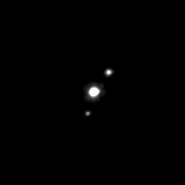Haumea, officially designated as 136108 Haumea is the third dwarf planet from the sun. It is known for its strange shape, because it spins so fast on its axis that it flattens out into an ellipsoid shape. It was discovered on December 28, 2004. It has two known moons called Hi'iaka and Namaka. It has a diameter of 1,632 km.
Discovery
The discovery of Haumea is controversial. Two teams lay claim to the discovery: Michael Brown, Chad Trujillo, and David Rabinowitz's team at Caltech, and Jose Luis Ortiz Moreno's team at a Spanish Observatory. The name Haumea was proposed by Brown's team, Ortiz's team proposed the name "Ataecina." Precovery images have been dated to March 22, 1955.
Name
Brown's team nicknamed it "Santa" when they found it because it was around Christmas time. Its provisional designation, 2003 El61, was given on July 29, 2005. Its number, 136108, was given on September 7, 2006. The name Haumea is the Hawaiian goddess of childbirth and fertility.
Physical characteristics
Haumea is oval shaped, and the only dwarf planet that is not a spheroid, but a Jacobi Ellipsoid. Such an oval shape sparks controversy on its current status as a dwarf planet, but the IAU has not made any demotions yet.
Haumea is mainly rocky, with a thin coating of ice. It has a large spot that is red in color, It is maybe because that area is covered in tholins.
Rotation
Haumea rotates extremely fast; it's day is only 3.9 hours long. This is why it is so oval-shaped; it stretches itself out.
Ring
- Main article: Rings of Haumea
A stellar occultation observed on 21 January 2017 and described in an 11 October 2017 ''Nature'' article indicated the presence of a ring around Haumea. This represents the first ring system discovered for a TNO. The ring has a radius of about 2,287 km, a width of ~70 km and an opacity of 0.5. It is well within Haumea's Roche limit, which would be at a radius of about 4,400 km if it were spherical (being non-spherical pushes the limit out farther). The ring plane approximately coincides with Haumea’s equatorial plane and the orbital plane of its larger, outer moon Hi’iaka. The ring is also close to the 3:1 resonance with Haumea's rotation (which is at a radius of 2,285 ± 8 km). The ring contributes around 5% to the total brightness of Haumea.
Collisional family
- Main article: Haumea Family
The Haumea Family is the only collisional family in the Kuiper Belt. It most likely formed from a collision (probably the same one that gave the dwarf its oblateness, moons, and rings) with another body. The family itself is composed of small (and large) bodies (called Haumeids). These bodies share multiple characteristics with Haumea, including composition, albedo, specta, and others.
Moons
Haumea has 2 known moons.

Namaka.
Namaka
Main Article: Namaka
Namaka is the smaller, inner moon of the dwarf planet Haumea. It is named after Namaka, the goddess of the sea in Hawaiian mythology and one of the daughters of Haumea.

Hi’aka.
Hi'iaka
Main Article: Hi’iaka
Hiʻiaka is the larger, outer moon of the dwarf planet Haumea.
Gallery/Images
| Dwarf Planets and Dwarf Planet Candidates | ||
|---|---|---|
| Asteroid Belt | Consensus | Ceres |
| Possible | Hygeia • Vesta | |
| Centaurs | Possible | Chariklo • Chiron • 2013 TC₁₄₆ • 2014 NW₆₅ |
| Plutinos | Consensus | Orcus • Pluto |
| Possible | Huya • Ixion • 2001 QF₂₉₈ • 2002 VR₁₂₈ • 2002 XV₉₃• 2003 AZ₈₄ • 2003 UZ₄₁₃ • 2003 VS₂ • 2007 JH₄₃ • 2017 OF₆₉ | |
| Twotinos | Possible | 2002 WC₁₉ |
| Cubewanos and other Kuiper Belt Objects | Consensus | Haumea • Makemake • Quaoar |
| Possible (cubewanos) | Chaos • Salacia • Varda • Varuna • 1998 SN₁₆₅ • 2002 AW₁₉₇ • 2002 CY₂₄₈ • 2002 KX₁₄ • 2002 MS₄ • 2002 UX₂₅ • 2002 QW₉₀ • 2004 GV₄ • 2004 NT₃₃ • 2004 PF₁₁₅ • 2004 TY₃₆₄ • 2004 UX₁₀ • 2005 RN₄₃ • 2005 UQ₅₁₃ • 2010 FX₈₆ • 229762 Gǃkúnǁʼhòmdímà | |
| Possible (other) | 1999 CD₁₅₈ • 1999 DE₉ • 2000 YW₁₃₄ • 2002 XW₉₃ • 2010 JO₁₇₉ • 2010 VK₂₀₁ • 2011 FW₆₂ • 2011 GM₂₇ • 2013 FZ₂₇ • 2014 UM₃₃ • 2015 AM₂₈₁ • 2015 RR₂₄₅ | |
| 136108 Haumea | |
|---|---|
| Moons and Rings | Hi'iaka • Namaka • Rings |
| Collisional Group | (19308) 1996 TO₆₆ • (24835) 1995 SM₅₅ • (55636) 2002 TX₃₀₀ • (86047) 1999 OY₃ • (120178) 2003 OP₃₂ • (145453) 2005 RR₄₃ • (308193) 2005 CB₇₉ • (386723) 2009 YE₇ • (416400) 2003 UZ₁₁₇ • (612620) 2003 SQ₃₁₇ |
| The Planets and Dwarf Planets | |
|---|---|
| Planets | |
| Mercury • Venus • Earth • Mars • Jupiter • Saturn • Uranus • Neptune | |
| Dwarf Planets | |
| Ceres • Pluto • Haumea • Makemake • Quaoar • Eris | |





